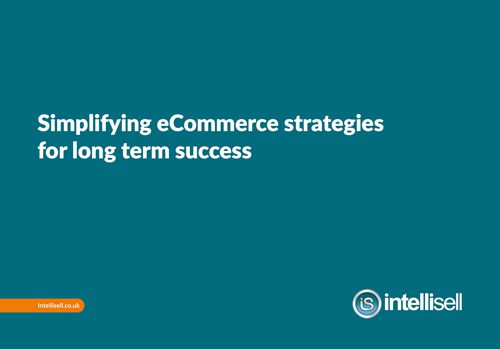Integrated eCommerce
for Sage Intacct
A flexible integration platform that can grow with your Sage Intacct business


Sage Intacct eCommerce
Sage Intacct is a best-in-class financial management solution used by thousands of growing, ambitious organisations. Intellisell integrates with Sage Intacct to extend the power and logic of Sage Intacct across your business.
Simplify your business processes and automate labour-intensive jobs to save time and reduce errors with the Intellisell integration platform. You can grow your business through easy connections to familiar marketplaces, couriers, 3PL or FBA.
The benefit of real-time, accurate reporting ensures that your business can stay ahead of the competition and spot new opportunities. Extend the reach of your sales force, using Intellisell as a sales or trade portal, giving existing customers access to order and self-service information on products, stock, special pricing, and account status.
Cloud-based, always on platform
Reliable and resilient high-availability cloud solution to maximise efficiency and ensure that you can focus on running your business, not managing software.
Connect Sage Intacct to your marketplaces
Intellisell helps you to leverage the power of leading eCommerce platforms, such as Magento, Shopify, Amazon and eBay. Gain greater control over the demands of a multi-channel environment.
3PL, courier, FBA control
Connect to third party suppliers to gain control and visibility and update buyers automatically on order status. Join the dots between Sage Intacct, CRM and your third party ecosystem to improve service levels.
Minimise manual processes
Automate manual processes to streamline efforts between departments. Operations and fulfilment have greater visibility and gain efficiency and productivity boosts.
Dynamic reporting across the business
Access to real time customer information, product and promotion trends, sales analysis and customer returns to give you valuable insight into what is really happening in your organisation and markets.
Increase customer loyalty
Service existing customers with easy self service and rapid repeat ordering. Increase average order value with cross sell and upsell offers. Strong user-experience and efficient fulfilment to boost customer satisfaction.
Give sales a dynamic sales portal
You can now sell across all devices, so your sales and trade desk team can access your site on the road, accessing customer-specific, pricing, promotions and account records.
Intellisell
Some of the partners we work with

Intellisell grows with your Sage Intacct business
As a growing business, you want to rely on technology that just works. Intellisell connects disparate solutions across your company to help you simplify your operations, automate routine proceeses and get powerful data insights to help formulate your next step.
Your customers can access their dynamic account information held in Intacct from invoices to payment history, previous orders to their own custom-specific pricing and promotions.
Secure, accessible and up to date.

Call us on 0344 880 6140
or chat with an expert.
Want to book a consultation with a Sage Intacct eCommerce specialist?
General Contact Form
Intellisell supports your whole business

Customer Success
Powered by Intellisell
View the latest case studies from Intelisell.
Resource Centre
Five principles of eCommerce design to consider
Five principles of eCommerce design to consider When approaching your eCommerce project there are few things to consider. And none more likely to garner constructive criticism than the design of...
Intro 2020 increases revenue with Intellisell
Intro 2020 increases revenue with Sage integrated Intellisell eCommerce Based in Maidenhead Berkshire, Intro 2020 has been importing and distributing photo, optical and video products for almost 50...
Five essential housekeeping jobs before launching eCommerce
If you’re selling a product, you need to have an eCommerce site to compete effectively and service your customers to the extent that they’ve become accustomed to when they buy any products or...
How to maximise Direct-to-Consumer business opportunities
The pandemic has compelled many businesses to make extraordinary changes to their business model. One of the most significant has been to reconsider the supply chain and, where possible, cut out the...
Is your business ready for eCommerce integration with Amazon?
Perhaps the biggest winner of the global coronavirus pandemic has been the eCommerce industry. As stores closed and restrictions on footfall were introduced, online shopping thrived with consumers...
FAQs
What is an eCommerce system or platform?
It is a system that enables electronic payments online. There are different ways that merchants can offer these payments. Some choose to offer fully integrated software solutions or third-party systems managed by service providers such as PayPal and WorldPay.
Many components make up an eCommerce system. These features could include; the shopping cart, integration capabilities, and security infrastructure. Each offers an important part in making sure that the system runs efficiently for both the merchant and their customers.
eCommerce integration involves implementing a shopping cart, merchant accounts, payment gateways, and security mechanisms with your website. This all helps to provide the merchant with an eCommerce system and a seamless shopping experience for the end customer.
So if we think of the software as the engine behind the scenes of an online store, then the system enables electronic payments. The software manages inventory, allows you to add or remove products, calculate the charges, order fulfilment etc.
By way of showing a friendly user interface people from non-technical backgrounds can manage the entire eCommerce operation. The back end of the interface is very multifaceted and a complex machine.
Any viable eCommerce software will enable customers to buy your products and services from your online store. Where solutions differ is the degree to which they can unify and leverage both front and back-office applications with both their unique and shared data. eCommerce platforms provide the unification of core business processes, where businesses can gain complete visibility across their company and ultimately meeting their most discerning customers’ expectations.
An eCommerce platform should allow for integrations between separate systems including; accounting, POS, inventory and order management, marketing, merchandising, customer service and financials on a cloud-based platform.
The benefits of having the software integrated allows you to provide reliable, consistent and personalised cross-channel experiences. You can offer superior customer service through a single view of all interactions and transactions across all touchpoints and channels.
You can also go above and beyond your customer expectations and increase your revenue by taking control of your orders and have one single view of what inventory you have across multiple channels and supply chains.
What are the most common types of eCommerce Software?
On-Premise: These are managed onsite by developers who take control of the manual updates and carry out any fixes that may need to be resolved. It offers merchants flexibility over hosted solutions. However, SaaS is becoming the preferred option, which you can discover more about below.
SaaS: Software as a Service (or “hosted”) solutions are much more detached from developers, in simple terms it isn’t maintained through company hard drives, you access it via the internet
The only requirements from development teams are usually for supplementary custom design features. You will be able to action any updates with one click or they happen automatically. This makes it a better choice for online merchants. It saves time for eCommerce stores using SaaS software and it’s also so much cheaper than on-premise solutions.
What is an Enterprise Resource Platform (ERP) eCommerce integration?
This is referring to the automation between the back office and the website. Automatic updates of product, price, stock and then the processing of customer and order details.
What is a payment gateway?
A payment gateway is a technology used by merchants to accept debit or credit card purchases from customers. So once you hit the buy button on a website, the payment gateway comes into action.
The next step is adding your bank card details. It is the front-end technology in charge of sending customer information to the merchant acquiring bank, for processing.
It then returns the transaction details and response from the payment network to the website you purchased from to inform them that the card is authorised, and therefore the order is completed.
In physical stores, payment gateways consist of the point of sale (POS) terminals used to accept credit card information by card or by smartphone. In recent years have begun accepting phone-based payments using QR codes or Near Field Communication (NFC) technology.
In online stores, payment gateways are the “checkout” portals used to enter credit card information or credentials for services such as PayPal.
Now that we have chip technologies, the signature phase on a credit/debit card has been replaced with a personal identification number (PIN) entered directly into the payment gateway hardware.
Contactless purchases are now so popular, and most of us now use our phones as payment devices instead of plastic credit cards.
Sign up to our newsletter for the latest Intellisell news and insights
Newsletter subscription
Get in touch to see
Intellisell in action
Accelerate your business today with an agile all in one eCommerce solution
General Contact Form
This site is protected by reCAPTCHA and the Google
Privacy Policy and Terms of Service apply.







